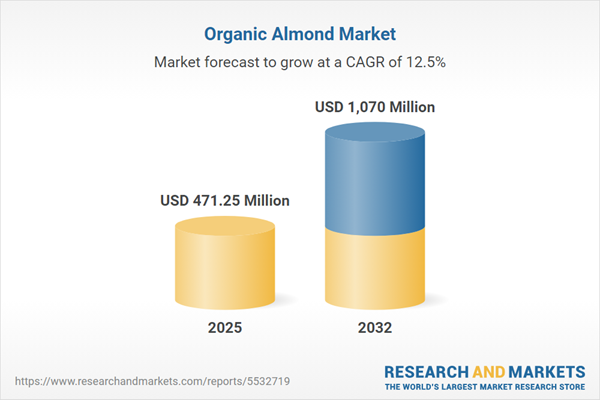Speak directly to the analyst to clarify any post sales queries you may have.
The organic almond market is rapidly evolving as businesses respond to dynamic supply chains, elevated sustainability standards, and increasing regulatory expectations. Senior executives need actionable market intelligence to manage risks and seize emerging growth opportunities in this changing business environment.
Market Snapshot: Organic Almond Market Size and Forecast
The global organic almond market reached USD 418.78 million in 2024, recording a compound annual growth rate (CAGR) of 12.49%. The market is expected to achieve approximately USD 471.25 million by 2025 and is projected to exceed USD 1.07 billion by 2032. This robust trajectory reflects heightened interest in certified organic ingredients, strengthened supplier networks, and the growing prevalence of value-added almond products. Companies that emphasize agile supply chain management and sustained innovation can secure greater reach and resilience amid evolving regulatory and consumer landscapes.
Scope & Segmentation: Unlocking Organic Almond Market Opportunities
- Form: Whole, diced, slivered, sliced, and powdered forms serve diverse requirements in food manufacturing, foodservice, and specialty ingredient applications—enabling manufacturers to customize product development for specific industry verticals.
- Application: Core uses include bakery, confectionery, snack foods, and plant-based dairy. These segments align well with wellness and functional food trends, helping businesses remain competitive as consumer diets shift.
- Process: Raw, blanched, and roasted processing methods provide differentiation options, allowing brands to target retail, hospitality, and foodservice channels seeking distinctive flavors and textures.
- Distribution Channel: E-commerce platforms, specialty stores, supermarkets, and hypermarkets improve market accessibility and allow for nimble adaptation to fluctuating demand patterns.
- End User: Foodservice operators, industrial processors, and retailers are primary market drivers, each with distinct supply cycle needs that require responsive inventory and sales strategies.
- Geography: North America, Latin America, Europe, Asia-Pacific, and the Middle East and Africa present unique challenges, such as local compliance, consumer preference shifts, and trade regulations. Adaptability in marketing and logistics is essential for success in each region.
- Key Companies: Market progress relies heavily on industry leaders like Blue Diamond Growers, The Wonderful Company LLC, Select Harvests Limited, Borges Agricultural & Industrial Nuts S.A.U., Mariani Nut Company, Sun-Maid Growers of California, John B. Sanfilippo & Son, Inc., Sahyadri Farms & Foods Pvt. Ltd., Sunnyland Farms, Inc., and Olam International Limited, all of which anchor supply stability and introduce continuous innovation.
Key Takeaways for Senior Decision-Makers
- Adoption of blockchain and digital traceability technology is increasingly necessary for transparency and smooth compliance with multi-jurisdictional regulations.
- Pursuing sustainability certifications alongside regenerative agricultural methods nurtures trust among commercial partners and end consumers alike.
- Launching plant-based and health-oriented product lines can enhance competitive advantage as organizations respond to lasting changes in consumer preferences.
- Forging strong alliances among growers, processors, and distribution partners elevates operational efficiency and helps safeguard against unpredictable external events.
- Embracing digital and e-commerce distribution channels enables quicker adaptation to evolving purchasing patterns and facilitates expansion into new markets across regions.
- Developing region-specific sales strategies that anticipate regulatory and cultural differences reduces potential operational bottlenecks and enhances international positioning.
Tariff Impact: Navigating US Trade Policy Shifts
Recent changes in US trade policy have prompted organic almond firms to reevaluate sourcing models and reinforce cost accountability. Domestic enterprises are intensifying efforts to localize their supply chains, while global stakeholders increasingly diversify procurement and highlight value-added processing. These actions help limit vulnerability to tariff changes and support sustained business operations in shifting policy contexts.
Methodology & Data Sources
This analysis leverages direct engagements with recognized industry executives, proprietary survey datasets, and comprehensive reviews of regulatory and academic documents. All findings are validated to ensure alignment with actual market conditions and to provide reliable guidance for strategic planning.
Why This Report Matters
- Enables leadership to confidently navigate evolving organic almond market trends, upcoming regulations, and effective strategic decision-making.
- Provides executive-level frameworks for embedding sustainability, increasing agility across the supply chain, and leveraging advanced digital technologies within the sector.
- Supports timely identification of opportunities and risk mitigation as markets mature and regional competition intensifies.
Conclusion
Leveraging insights from this report helps executive teams advance their market position, adapt to ongoing industry shifts, and realize sustainable growth within the organic almond sector.
Additional Product Information:
- Purchase of this report includes 1 year online access with quarterly updates.
- This report can be updated on request. Please contact our Customer Experience team using the Ask a Question widget on our website.
Table of Contents
3. Executive Summary
4. Market Overview
7. Cumulative Impact of Artificial Intelligence 2025
List of Figures
Companies Mentioned
The companies profiled in this Organic Almond market report include:- Blue Diamond Growers
- The Wonderful Company LLC
- Select Harvests Limited
- Borges Agricultural & Industrial Nuts S.A.U.
- Mariani Nut Company
- Sun-Maid Growers of California
- John B. Sanfilippo & Son, Inc.
- Sahyadri Farms & Foods Pvt. Ltd.
- Sunnyland Farms, Inc.
- Olam International Limited
Table Information
| Report Attribute | Details |
|---|---|
| No. of Pages | 184 |
| Published | November 2025 |
| Forecast Period | 2025 - 2032 |
| Estimated Market Value ( USD | $ 471.25 Million |
| Forecasted Market Value ( USD | $ 1070 Million |
| Compound Annual Growth Rate | 12.4% |
| Regions Covered | Global |
| No. of Companies Mentioned | 11 |









